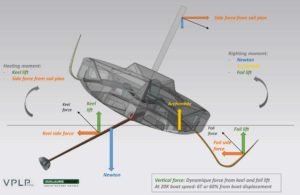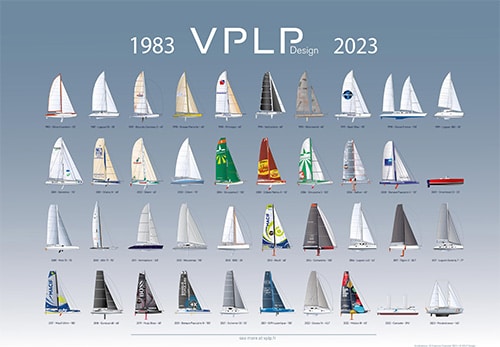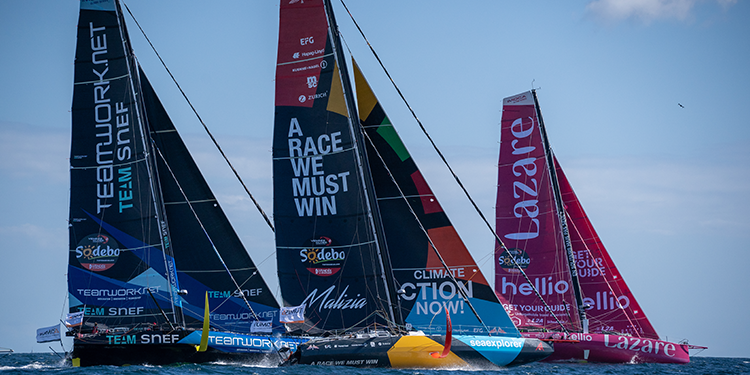Having designed 12 of the 29 boats taking the Vendée Globe starting line on Sunday 6 November, VPLP Design is undeniably the most prolific of all the naval architects taking part in this eighth edition – sharing the top spot with Team Verdier, of course! Vincent Lauriot-Prévost looks back over an exceptional adventure in yacht design.
How does a firm specializing in multihulls start making monohulls for the Vendée Globe?
Vincent Lauriot-Prévost: It’s a process that derived from a pragmatic observation. By the mid-2000s, after Groupama 2 and the decline of the ORMAs, we realized we had come to the end of a cycle and so we decided to focus our efforts on the IMOCAs. We were already in touch with Guillaume Verdier who, at the time, was working on Yves Parlier’s Hydraplaneur. He had done an internship with us, as well as a stint with Finot-Conq, the reference in monohull design back then. We thought about designing an IMOCA but neither of us felt we had the credibility to do it on our own.
And yet together, in 2006, you secured the Safran contract, didn’t you?
Vincent Lauriot-Prévost: Yes, we kicked around an idea for an Ultimate for Florence Arthaud, which we offered to Safran. And when Safran chose the IMOCA we worked on Marc Guillemot’s project, who was a candidate for the position of skipper. When Safran selected him, we signed on too. And the sponsor wasn’t unhappy about initiating a revolution in yacht design.
What was this revolution in yacht design exactly?
Vincent Lauriot-Prévost: Up until then the boats were heavy and powerful. We thought we could design monohulls that, like multihulls, were still powerful but light. So we undertook a zero-tolerance approach to saving weight. As for the power, we got that from designing squarer lines, with sharper bilges running the length of the hull. At the same time, we moved the rigging further aft, shortened the boom and steepened the stays to lift the bow out of the water. We did a lot of work on the tilt of the keel, by increasing its angle of attack considerably, and we developed curved daggerboards to promote lift, and we simplified the forces. All that produced, even in the first-generation IMOCAs, boats that were more responsive, faster and easier to handle. Our first IMOCAs weighed up to 1.5 tonnes lighter than those of our competitors!
Are the foils a revolution too?
Vincent Lauriot-Prévost: Previously, when we lightened a boat it had an impact on the righting moment, and that was something we just accepted. Today, thanks to the foils, we can lighten a boat without losing any righting torque – yes, it is the innovation of the decade, no doubt about it! And keel tilt has gone from 2° to 7°, and that produces more lift. At 22 to 25 knots a foiling IMOCA reduces its displacement by almost half without losing power…
But foils are more of a hindrance than a help in light airs and sailing close-hauled, aren’t they?
Vincent Lauriot-Prévost: For the early versions of the foils, that was true. But most of the imperfections have been ironed out of the V2s. We had designed asymmetric shafts to generate vertical lift but, when heeling, we noticed that they had the opposite effect. We discovered it’s the curve between the tip and the shaft which delivers the vertical lift. So we drew up some symmetrical shafts, as neutral as possible, and the V2 gained enormously in stability.
What can we expect for the next generation of IMOCAs?
Vincent Lauriot-Prévost: Unless a disaster happens, the class won’t be changing much. We suggested that there needs to be greater equality between the generations. The early boats gain a huge advantage from the current rules because they can keep their original mast, and reinforce it, whereas the latest IMOCAs are, without a shadow of a doubt, hindered by their standardized mast. On the design side, we are going to look at improving the hulls which, for example, could be made less beamy. Don’t forget, all the teams asked us to draw up hulls that could revert to daggerboards if the foils didn’t work! But, for the moment, nobody had asked us…







